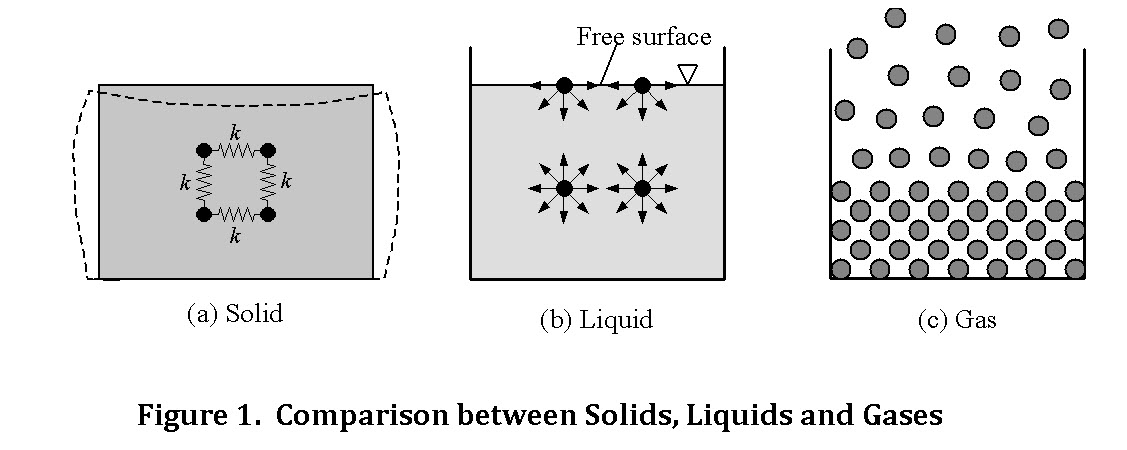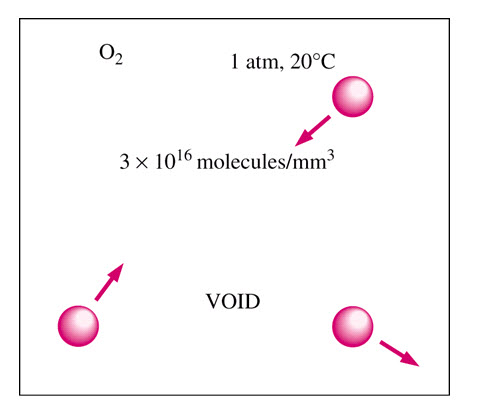Site pages
Current course
Participants
General
MODULE 1. FLUIDS MECHANICS
MODULE 2. PROPERTIES OF FLUIDS
MODULE 3. PRESSURE AND ITS MEASUREMENT
MODULE 4. PASCAL’S LAW
MODULE 5. PRESSURE FORCES ON PLANE AND CURVED SUR...
MODULE 6.
MODULE 7. BUOYANCY, METACENTRE AND METACENTRIC HEI...
MODULE 8. KINEMATICS OF FLUID FLOW
MODULE 9: CIRCULATION AND VORTICITY
MODULE 10.
MODULE 11.
MODULE 12, 13. FLUID DYNAMICS
MODULE 14.
MODULE 15. LAMINAR AND TURBULENT FLOW IN PIPES
MODULE 16. GENERAL EQUATION FOR HEAD LOSS-DARCY EQ...
MODULE 17.
MODULE 18. MAJOR AND MINOR HYDRAULIC LOSSES THROUG...
MODULE 19.
MODULE 20.
MODULE 21. DIMENSIONAL ANALYSIS AND SIMILITUDE
MODULE 22. INTRODUCTION TO FLUID MACHINERY
LESSON 2. FLUID
2. Fluid concept
With exception to solids, any other matters can be categorised as fluid. In microscopic point of view, this concept corresponds to loose or very loose bonding between molecules of liquid or gas, respectively.

(For solid, imagine that the molecules can be fictitiously linked to each other with springs)
-
In fluid, the molecules can move freely but are constrained through a traction force called cohesion. This force is interchangeable from one molecule to another.
-
For gases, it is very weak which enables the gas to disintegrate and move away from its container.
For liquids, it is stronger which is sufficient enough to hold the molecule together and can withstand high compression, which is suitable for application as hydraulic fluid such as oil. On the surface, the cohesion forms a resultant force directed into the liquid region and the combination of cohesion forces between adjacent molecules from a tensioned membrane known as free surface
2.1. Distinction between Liquid & Gas is based on:
Compressibility
Molecular spacing
2.2. Definition of Fluid
Word fluid: A substance having particles which readily change their relative position.
Definition of Fluid: A substance which deforms continuously under the action of shear stress, regardless of its magnitude.
2.3. Fluid continuum
Since the fluid flows continuously, any method and technique developed to analyse flow problems should take into consideration the continuity of the fluid. There are two types of approaches that can be used:
2.3.1 Eulerian approach
Analysis is performed by defining a control volume to represent fluid domain which allows the fluid to flow across the volume. This approach is more appropriate to be used in fluid mechanics.
2.3.2 Lagrangian approach
Analysis is performed by tracking down all motion parameters and deformation of a domain as it moves. This approach is more suitable and widely used for particle and solid mechanics.
The fluid behaviour in which its properties are continuous field variables, either scalar or vector, throughout the control volume is known as continuum. Strong inter molecular cohesive force compel the fluid to behave as a continuous mass.

From this concept, several fluid or flow definitions can be made as follows:
Steady state y a function of position (x,y,z) but not time t:
r = r (x,y,z), V = V (x,y,z)
An example is the velocity of a steady flow of a river where the upstream and downstream velocities are different but their values does not change through time.